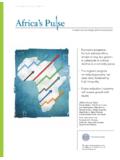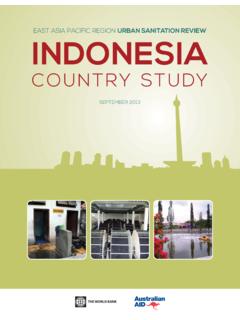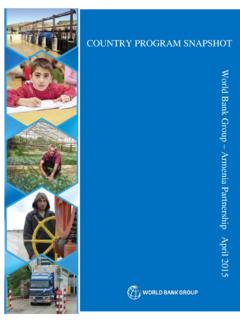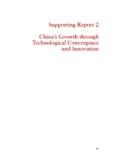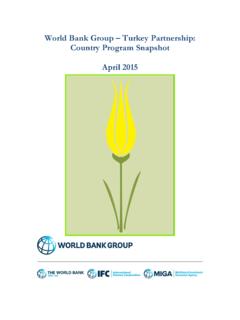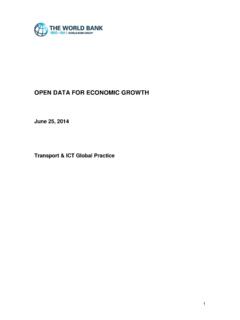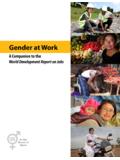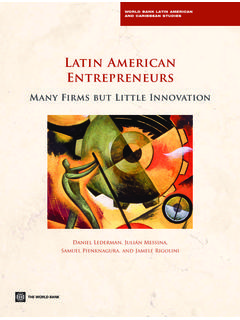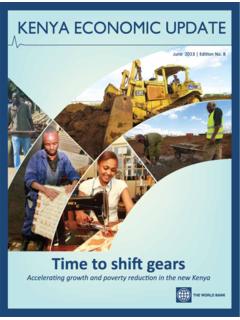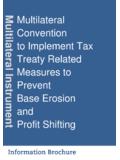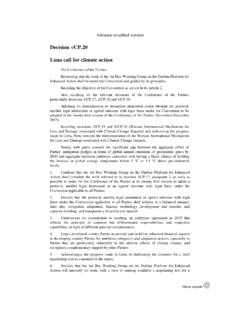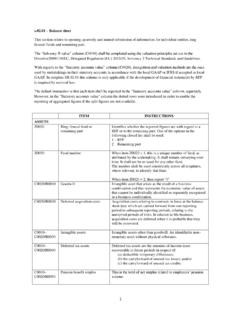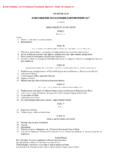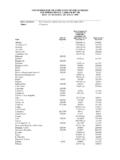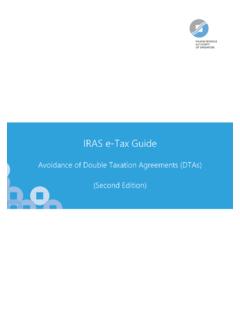Transcription of contact information: …
1 JOINT REPORT ONMULTILATERAL DEVELOPMENT BANKS CLIMATE FINANCE 2014download access: information : JOINT REPORT ON multilateral DEVELOPMENT BANKS CLIMATE FINANCEJune 2015 This report was written by a group of multilateral Development Banks (MDBs), comprised of the African Development Bank (AfDB), the Asian Development Bank (ADB), the European Bank for Reconstruction and Development (EBRD), the European Investment Bank (EIB), the Inter-American Development Bank (IDB), and the International Finance Corporation (IFC) and the World Bank (WB) from the World Bank Group (WBG). The findings, interpretations, and conclusions expressed in this work do not necessarily reflect the views of the MDBs, their Board of Executive Directors, or the governments they ..3 EXECUTIVE SUMMARY ..4 INTRODUCTION ..6 SECTION 1: MDB CLIMATE FINANCE, 2014 ..8 Part A: Total MDB Climate Finance, 2014 ..8 Sources of climate finance.
2 9 Nature of recipient Public and private recipients ..10 Instrument type ..10 Geographical distribution of finance by region ..12 Part B: MDB Climate Finance Commitments, 2011 2014 ..14 Part C: MDB Adaptation Finance, 2014 ..15 Part D: MDB Mitigation Finance, 2014 ..19 SECTION 2: GENERAL ..23 Part A: Definitions and Clarifications ..23 Part B: Geographical Coverage of the Report and Regional Breakdowns ..24 Part C: Guidance Section on the Adaptation Finance Tracking Methodology ..26 Part D: Joint MDB Approach for Mitigation Finance Reporting ..34 ANNEX A . FINANCE wITh DUAL ADAPTATION AND MITIGATION BENEFITS ..42 ANNEX B . INSTRUMENT TYPES ..43 ANNEX C . MDB MITIGATION FINANCE OUTSIDE ThE JOINT METhODOLOGY ..43 PREFACETo stabilize warming at less than 2 degrees Celsius, as the international community agreed in 2009, the world will have to cut greenhouse gas emissions to net zero before 2100. Finance and economic policy that helps shift the world to a cleaner trajectory will be the key to mobilizing that global , it is increasingly clear that the finance required for a successful, orderly transformation to a growing low-carbon and resilient global economy is counted in the trillions and not billions.
3 The immediate challenge of climate finance is to meet the promise made by developed countries to mobilize USD 100 billion a year by 2020. Meeting this commitment is critical to building trust and confidence around the UN climate negotiations in Paris later this year. The multilateral Development Banks (MDBs), together with other public development finance institutions, play a strategic role in smartly deploying scarce government resources and leveraging much larger, and longer-term, private investments. This fourth edition of the Joint Report on MDB Climate Finance reveals the important part they play in delivering development and climate action. In 2014, the MDBs committed over USD 28 billion for climate action in developing and emerging economies, bringing total commitments of the past four years to over USD 100 billion. This financing has supported policy changes and investments that provide development, adaptation and mitigation benefits directly to our client countries.
4 It has helped, for example, to improve agriculture and landscape management, made coastal and riverine infrastructure more resilient, improved the efficiency of water use and water management in cities and industries, and supported community driven adaptation activities. It has ramped-up mitigation efforts through energy efficiency, renewable energy and support for lower-carbon transport options. There have increasingly been questions on what gets counted as climate finance. As a group of the MDBs, we have developed a transparent methodology. Over the last year, we have harmonized our principles for tracking climate mitigation finance with the International Development Finance Club (which consists of development banks of national and sub-regional origin) and have started a process for harmonizing approaches for adaptation finance. As MDBs, we are committed to work with clients, other development finance institutions and stakeholders to provide transparent, credible and robust information that demonstrates how climate finance is hope that this Joint Report on MDB Climate Finance provides useful information on MDB development finance with climate benefits, and help to guide decision making at the Third International Conference on Financing for Development in Addis Ababa next month, as well as key data for the Paris climate discussions.
5 Given the pivotal role of public finance agencies in scaling up climate finance, multilateral Development Banks (MDBs) have a major role to play in mainstreaming climate change and in providing finance in an effective, catalytic manner. Transparent and credible information on finance flows are essential to demonstrate the effectiveness of delivering impacts on the ground. This is the fourth edition of the Joint Report on MDB Climate Finance. The report covers financing for climate change mitigation and adaptation projects and activities, in developing and emerging economies, committed by this group of MDBs1 in This report contains the following new information , not presented in previous years: Overview of MDB climate finance from 2011 to 2014; information about the financial instruments used by MDBs for climate finance; and Additional thematic regional coverage, including small island states and least developed is tracked and reported in a granular manner, corresponding only to the financing of those components (and/or subcomponents) or elements/proportions of projects that directly contribute to (or promote) mitigation and/or adaptation.
6 Adaptation finance is calculated using the MDB methodology, which is based on a context- and location-specific approach. Mitigation finance is also based on the MDB methodology (following an activity typology), and is closely aligned with Common Principles for Climate Mitigation Finance Tracking agreed by the MDBs and by the International Development Finance Club (IDFC) and published in March 2015. The MDBs committed over USD 28 billion to projects in developing and emerging economies to address climate change in 2014. Eighty-two percent, or over USD 23 billion, was dedicated to mitigation; and 18 percent, or USD 5 billion, to adaptation, as illustrated in Figure A (a small amount of this finance has dual, adaptation and mitigation, benefits please see Annex 1 for details). Of the total commitments, 91 percent came from MDBs own resources, while the remaining 9 percent, or USD billion, came from external resources such as bilateral or multilateral donors, the Global Environment Facility (GEF), and the Climate Investment Funds (CIF).
7 In 2014, MDB climate finance covered a broad geographical area: South Asia received the most with 21 percent of total climate finance commitments, followed by Latin America and the Caribbean with 17 percent; non-EU Europe and Central Asia with 16 percent; and Sub-Saharan Africa with 15 percent. Regarding sectoral coverage, 23 percent of 1 The African Development Bank (AfDB), the Asian Development Bank (ADB), the European Bank for Reconstruction and Development (EBRD), The European Investment Bank (EIB), the Inter-American Development Bank (IDB), and the International Finance Corporation (IFC) and the World Bank (WB) from the World Bank Group (WBG).2 Data covers fiscal year 2014. Even though MDBs do not follow the same reporting cycle, data remains comparable across MDBs as all reporting cycles correspond to a 12-month Total Climate Finance in 2014 was USD 28,345 millionAdaptationFinance18%MitigationFin ance82%Figure A: Split of MDB Climate Adaptation and Mitigation Finance, 2014 EXECUTIVE SUMMARY Executive Summary5adaptation finance went to Energy, Transport and Other Built Environment and Infrastructure while 19 percent went to Other Agricultural and Ecological Resources ; 17 percent went to Crop Production and Food Production ; and another 17 percent went to Coastal and Riverine Infrastructure (including built flood protection infrastructure).
8 Regarding mitigation finance, Renewable Energy comprised 35 percent of the total; Transport, 27 percent; and Energy Efficiency, 22 percent, with the other categories accounting for the balance. The MDBs have been jointly publishing climate finance figures for the past four years. Since 2011, the MDBs have collectively committed over USD 100 billion to address climate change in developing and emerging economies. Figure B shows the annual numbers per ,00010,00015,00020,00025,00030,00005,000 10,00015,00020,00025,00030,000 WBIFCIDBEIBEBRDADBAfDBTotal1,6393,1773,7 295,6372,1701,6818,98127,0142,2203,2843, 1313,6631,8701,58811,09026,8461,2053,268 3,4605,2241,2202,6696,75723,8031,9162,85 64,1115,2142,4612,5589,22928,345 Figure B: Total Climate Financing by MDB, 2011 2014 (USD millions)Note: EIB numbers for all four years are restricted to developing and emerging economies in transition, therefore excludes EU-15 countries where EIB is also active.
9 EIB numbers for 2011 were amended (from that in the 2011 reports) to include EU-13 climate finance numbers, allowing for full geographical comparability among all four Joint Report on MDB Climate Finance captures a particular context of activities that multilateral Development Banks (MDBs) carry out in developing and emerging economies. The context is built on the premise that development finance is being provided in a world shaped by climate change. This is the fourth year that MDBs have carried out joint reporting on climate report is based on the joint MDB approach for climate finance tracking and reporting, for which details are provided in Section 2. The MDBs have worked consistently to improve this joint approach and refine reporting. This year s report was coordinated by the World Bank Group and prepared by professional staff from the following MDBs: African Development Bank (AfDB), Asian Development Bank (ADB), European Bank for Reconstruction and Development (EBRD), European Investment Bank (EIB), Inter-American Development Bank (IDB), and the International Finance Corporate (IFC) and World Bank (WB) from the World Bank Group (WBG) all together referred in the report as the 2015, the MDBs have worked closely with the International Development Finance Club (IDFC), a group of 22 leading development finance institutions and regional banks around the world, to more closely align their approaches on mitigation finance tracking.
10 On March 31st, 2015, the MDBs and the IDFC jointly published the Common Principles for Climate Mitigation Finance Tracking,4 consisting of a set of common definitions and guidelines, including the list of activities for tracking mitigation finance, and agreed to continuously work on improving data transparency, collection processes and comparability of The MDBs and the IDFC are also in the process of collaborating on principles for tracking adaptation finance. The 2014 report includes the following additional information , not included in previous years, based on interest expressed by some groups and the availability of additional data: Overview of MDB climate finance from 2011 to 2014; information about financial instruments used by MDBs for climate finance; Additional thematic regional coverage, including small island states and least developed joint approach serves as a tool for the MDBs to consistently measure their financial contribution to climate change in a transparent and harmonized manner.

